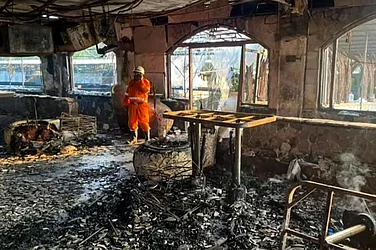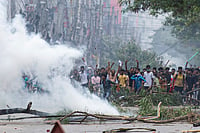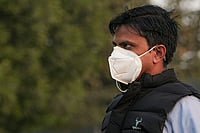A day ahead of the Assembly Election results in Uttar Pradesh as well as four other states, a familiar accusation has emerged - that of EVM tampering. On Tuesday, Samajwadi Party chief Akhilesh Yadav accused the ruling BJP of tampering with Electronic Voting Machines. The SP along with its allies Suheldev Bhartiya Samaj party and Janwadi Party (Socialist) claimed that two trucks laden with EVMs have gone missing in Varanasi after the March 7 voting. They have submitted a memorandum to the office of the Chief Electoral Officer in Lucknow.
While the allegations grabbed headlines, accusations of EVM tampering are not new in India, one of the 25 countries in the whole world that uses EVMs to vote. Ever since the formal adoption of EVMs as the mode of casting vote for both Lok Sabha and state assembly elections, politicians have accused parties of tampering with the machines, hacking into EVMs or stealing them to influence results. Interestingly, most major parties have been on both the receiving end of such accusations as well as the accusers.
In the 2017 Uttar Pradesh elections, for instance, the Bharatiya Janata Party's landslide victory was contested by several opposition parties including Bahujan Samaj Party, Samajwadi Party and Congress. The Congress has also accused BJP of tampering with EVMs in other state elections. In 2019, an Indian cyber expert by the name of Syed Shuja who claimed to have worked with the team that developed EVMs for the 2014 General Assembly elections, accused the BJP of rigging the machines. This was the same year that the BJP came to power.
While the government today swears by the sanctity of EVM, it was the BJP in 2009 that first raised the issue of EVM tampering after LK Advani demanded the return to ballot papers for voting in four states including Maharashtra.
Following Akhilesh Yadav's accusations which also incriminated administrative officials, Varanasi District Magistrate Kushal Raj Sharma said that the incident was a misunderstanding created by political parties. While admitting that 20 EVM machines were indeed being transported in a truck in Lucknow, they were not 'control room' EVMs that were used for polling but were 'training EVMs' used to train employees deputed for counting ahead of results.
While the incident is currently being investigated, here's what the laws say about EVMs in India:
What is an EVM and can it be hacked?
The EVM was first used in the Parur Assembly Constituency of Kerala in the year 1982 following which it was initially banned by the Supreme Court but later reinstated and eventually adopted. An EVM consists of two units - a ballot unit which is the machine a voter uses to cast their vote by pressing on the symbols for respective parties. The other is the control unit which is operated by the election officer present in each polling booth. Meaning each polling has two EVM units and can be used to cast up to 2,000 votes. In 1989, Bharat Electronics Limited and Electronics Corporation of India Limited were commissioned by the EC to develop these machines.
In 2017, after AAP's defeat in the Punjab Assembly elections, Arvind Kejriwal had demanded an enquiry into 'malfunctioning' EVMs and claimed that EVMs can be hacked into in 90 seconds. An AAP MLA, Saurabh Bhardwaj, even demonstrated in a public session how EVMs can be tampered with.
Following the accusations, the Election Commission which is charged with safeguarding electoral practices in the country invited all parties to prove their claims in June. However, no political party came forth to participate in the EVM challenge. Only CPI(M) and NCP came forward to show interest in the event but backed out in the last hour claiming they only wanted to learn the process. In an affidavit to Supre court which was hearing cases of EVM malfunctioning made by Congress and BSP in Uttar Pradesh in August, the EC asked political parties to not cry foul over EVMs when they skipped EC's challenge.
Experts, however, agree that while it may be possible to wirelessly hack an EVM, it may take a long time and may require close proximity to the units. This year, there were reports of glue being stuck on certain EVM ballots. Malpractices such as this constitute physical tampering.
What are the laws regarding the movement of EVM?
As per the Election Commission, only "authorized engineers of the manufacturers can conduct the First Level Checking (FLC) of EVMs and VVPATs under control of the District Election Officer and direct supervision of Deputy DEO in the presence of representatives of political parties under videography."
The ECI has in place ground rules for storage, transportation, testing and use of EVMs.
The storage and transfer of EVMs takes place in three stages.
About storage, the EC says: "It is reiterated that under no circumstances any person will take any EVM, whether polled EVMs or reserve EVMs in the custody of sector officers, to his home or any private place. All polled EVMs and all reserve EVMs after the poll shall be under cover of armed police a1 all times. Reserve EVMs should also be returned at the same time when the polled EVMs are returned at the receipt center. Reserve EVMs shall not be kept in the strong room meant for polled EVMs.They shall be kept in another strong room meant lor keeping reserve EVMs. It must be ensured that all reserve EVMs are also deposited in the strong room meant for reserve EVMs at the same time when the polled EVMs are deposited in the strong room meant for polled EVMs."
The EVM warehouses located at the district head quarters are under double lock, manned by two officers. The DEO has all the keys to the first lock while the Deputy DEO has all the keys for the second. EVM Warehouses outside of district headquarters follow a similar pattern and are manned bytwo officers. The officer in charge of first set of keys may not be lower than District collector or SDM rank while the officer in charge of second set may not be below 'tehsildar' rank.
At the time of counting, assembly-constituency wise EVMs are allocated and then transported to assembly-constituency wise strong rooms. These are also under double lock system managed by Returning Officer and Assistant Returning Officer.
After the counting is over, the EVMs are keptin the assembly-constituency wise strong rooms under double lock until the end of the election petition period. The keys to these strong rooms are with DEO and Deputy DEO. The strong rooms or warehouses can only be opened in the presence of these officers and require previous documentation and approval from requisite authorities.
All EVMs, VVPATs and Reserve EVMS must be transported to strong rooms on the same day under security cover.
In order to ensure safety of EVM and VVPATs during transportation and ensure against the loss or theft of EVMs, the EC uses several measures like tracking software, GPS devices in vehicles and mandatory video recording of the entire process. EVMs and Reserve EVMs must be stored in different locations.
In 2019, several videos of EVM and VVPAT machines lying unattended outside strong rooms or inside people's houses. The EC has, however, repeatedly refuted allegations of EVM tampering.
According to the section 58 of the Representation of the People Act, 1951, fresh elections need to be held if any "ballot box used at a polling booth is unlawfully taken out of the custody of the presiding officer or the returning officer, or is accidentally or intentionally destroyed or lost, or is damaged or tampered with, to such an extent, that the result of the poll at that polling station or place cannot be ascertained; or 2[(aa) any voting machine develops a mechanical failure during the course of the recording of votes, or if any such error or irregularly in procedure as is likely to vitiate the poll is committed at a polling station or at a place fixed for the poll".


























